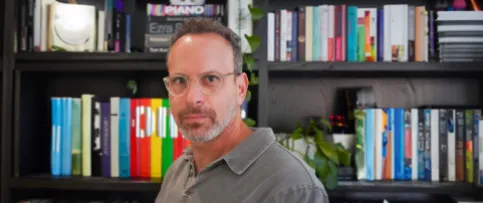We recently caught up with Alex Melvin, NCARB, to learn about his journey through the field of architecture! An architect at Boston firm, Embarc, Alex shares about his favorite projects, what drew him to the profession, and his unexpected passion for teaching.
Did you grow up wanting to be an architect? What drew you to the field?
That plastic treasure chest filled with colorful LEGOs hidden beneath my childhood bed—that’s what drew me into the field. My brother (+3.5 years) and I both grew up with a level of exploratory freedom to chase our interests, and my mother swears that LEGOs were one of the toys that really exposed our futures. My brother would build gizmos and downhill cars (he’s now a mechanical engineer), and I would sort the bricks by size and color before building structures and houses on my bedroom floor.
I am one of the fortunate ones who grew up never doubting the desire to be an architect (second to becoming a professional baseball player, of course), but without really understanding what an architect even was. One of my childhood best friend’s father was a practicing architect, but that was the only direct exposure I had to what an architect was.
I grew up with some awesome parents who promoted creative interests, whether it was music, painting, drawing, writing, welding, electronics, mechanics, or anything in between. Having an older brother to go through all of this with, I believe, was the true foundation for my journey as an architect. My father raised us to fix what we broke and take pride in the work we produce. He told us that if you want something done right, you do it yourself, and if you’re not going to give a job your all, don’t commit to doing it.
You completed testing for the Architect Registration Examination® (ARE®) in just over a year. What kept you motivated throughout the process?
Motivation has never really been an issue for me regarding architecture. The most difficult part was getting study time in every morning and giving up the weekends to study all day. I would say teaching while studying was one of the factors that made the difference for a few of the exams. As Albert Einstein said, “If you can’t explain it simply, you don’t understand it well enough”—so in a way, I was using the drive to help my students get the best education I could provide to keep me focused on my own goals.

Why was it important to you to become licensed?
Getting licensed wasn’t the end goal by any means, but rather a milestone on the way to becoming a practicing architect. I think the importance of passing the exams and becoming licensed for me was simply the pride in finally being able to call myself an architect after so many years. The next licensure goal is to get my Construction Supervisor License (CSL).
Why did you decide to study abroad while completing your architectural education? What impact did that experience have on you, both personally and professionally?
One of my favorite aspects of architecture is the fact that, when diluted down to its primary purpose of providing respite from the elements, architecture is the same everywhere. But the moment you introduce a change in climate, culture, geography, resources, you start to unveil the most beautiful aspect of architecture: every different place has new and unique challenges to face on micro and macro scales—geographically, politically, socially, and economically.
At the University of Florida’s architecture program, most of the students participate in one of the programs that the college offered—either a full semester in Vicenza, Italy, or a shorter (less expensive) summer semester in Guadalajara, Mexico. After the Guadalajara summer studio, the travel bug bit me hard. The year following my trip to Mexico, when I had completed my architecture degree and had one more year to complete my construction management degree, I had the opportunity to participate in an exchange program with the Royal Melbourne Institute of Technology (RMIT) in Melbourne, Australia, where I was the only student to go.
Personally, these two trips at that time in my life were so incredibly eye-opening for my perspective on life and seeing how place is defined not only by geographic location, but by the people who have been there, are there, and will be there. Professionally, the travel that impacted me the most would be my time at Leupold Brown Goldbach Architekten in Munich during the summers of 2015 and 2016 and the fall of 2020. Being able to work so closely with people from so many different countries all in one office changed my life for sure—I am still very close friends with the people I met while living in Munich.

You work at Embarc, which specializes in the multi-family and commercial sectors in Boston. What is your favorite project you’ve worked on there and why?
I have only been working at Embarc since April 2021, but I am currently working on a great project with Principal Bill Mensinger. The proposed project is a ~300-unit multifamily/mixed-use development just southwest of Boston. We are working with a client who really cares about the town and producing something worth being proud of, and we’ve got a great group of consultants on the team, working together to make this project a reality. When I joined the firm, the project was just beginning the schematic design phase, and I am beyond excited to have the opportunity to carry a project this large all the way through construction administration.
My favorite project that I have ever worked on was prior to starting here at Embarc. The project began as a collaborative competition entry for Boston’s E+ Green Building Program in 2016, with Leupold Brown, Goldbach Architekten, and Scott Payette Architects—and we won! Working as a contract employee for both firms simultaneously, I was able to lead the project (with constant support from both Wyly Brown and Scott Payette) through design development, construction documents, and construction administration; finally completed construction in August 2020; and was awarded LEED Platinum this summer in 2021.
The project is a four-unit condominium in Dorchester on Colonial Avenue. It is 25 percent affordable through the BPDA Affordable Housing Program and is an energy-positive building, producing more energy than it consumes. This was my favorite project I’ve worked on thus far, simply because it is a project I came onto as a graduate-school summer intern in Munich, and completed a year after becoming fully licensed. Looking back at the entire process, it was really the first project that I was all-in on and got to learn a lot of real, in-practice lessons that were imperative for my registration exams.
I primarily enjoy the tectonics of architecture; I think an architect should always be designing with construction in mind, always asking, “How am I going to build this?” When you continue to ask yourself this question, you find yourself designing efficient solutions that are also beautiful and simple to construct, and if they’re simple to construct, they perform better and can be constructed faster, saving time and saving money.
In addition to being a full-time architect, you also teach as an adjunct professor. What inspires you to teach?
I wouldn’t say I’m directly inspired to teach, but more inspired to be around learning and help facilitate learning wherever I can. But looking back, I did lead a life that led me to teaching. In high school, I was a teaching assistant for freshman biology, and I also worked as a teaching assistant throughout undergrad and graduate school for architectural design courses. So, you could say I’ve always had it coming—but if you were ever to have asked me if I wanted to be a teacher or professor, I never would’ve thought it would go past my own academic career as a student.
After meeting Rick and Laura Brown of Handshouse Studio in the woodshop at Washington University in St. Louis, in spring 2015, I began a very exciting journey working with, and learning from, so many incredibly inspiring and amazing artists and architects who are or have been academic professors. When you surround yourself with people who love to learn, you’ll find that their love for learning (and teaching) tends to rub off, and next thing you know, you find yourself teaching at the collegiate level and really enjoying it.
In fall 2018, a position opened up for an adjunct professor at Massachusetts College of Art & Design (where Rick and Laura were both teaching, and their son/my boss, Wyly, was an adjunct professor on the side as well) to teach Methods & Materials, and everyone gave me the push I needed to apply. After teaching a handful of courses, I can say that I truly enjoy the fact that I am able to share some of my knowledge with the upcoming generation of young architects in the classroom and in the shop, while primarily practicing architecture full time.



